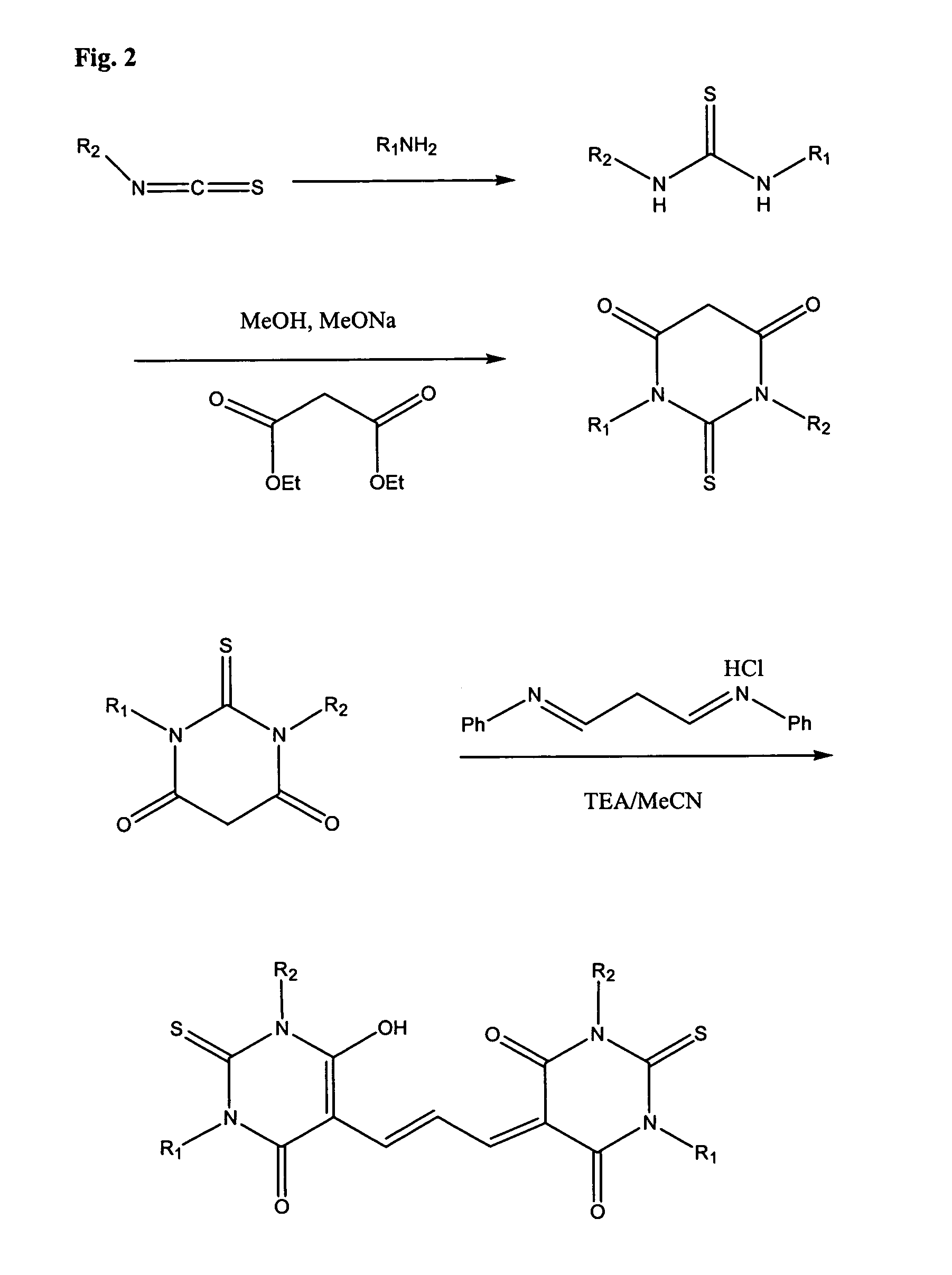Detection of transmembrane potentials using asymmetric thiobarbituric acid-derived polymethine oxonols
a technology of thiobarbituric acid and transmembrane potential, which is applied in the field of detection and measurement of transmembrane potentials using an asymmetric thiobarbituric acidderived polymethine oxonol, can solve the problems of high injurious puncture, mechanical difficulty, and limited measurement of membrane potentials in a single cell, and achieve the best optimized properties of optical measurement
- Summary
- Abstract
- Description
- Claims
- Application Information
AI Technical Summary
Benefits of technology
Problems solved by technology
Method used
Image
Examples
example 1
Synthesis of Compound 11
[0082]
[0083] For all the syntheses, all starting materials and reagents were of the highest purity available (Aldrich Chemical Company, Milwaukee, Wis.) and used without further purification, except where noted. Solvents were HPLC grade (Fisher Scientific, Pittsburgh, Pa.) and were dried over activated molecular sieves. NMR spectra were acquired on a Varian Gemini 200 MHz spectrometer. Absorption and fluorescence spectra were taken respectively on a Cary 50 BIO and Varain eClipse (Varian, Inc., Palo Alto, Calif.).
[0084] To 2 M ethylamine in THF (200 ml, 0.4 mol) methyl isothiocyanate (29.25 g, 0.4 mol) in THF (60 mL) is added proportionwise under stirring in an ice / water bath. The reaction mixture is stirred at room temperature overnight, and TLC (hexane / ethyl acetate=1 / 1) is used to confirm the completion of the reaction. Solvent is removed in-vacuo and the residue is further dried under high vacuum to give a syrup. The residue is then mixed with hexane 300...
example 2
Synthesis of Compound 12
[0085]
[0086] To anhydrous methanol (160 mL) is added sodium (9.2 g, 0.4 mol) in small piece with a setup of cooling condenser. During the addition the reaction mixture is spontaneously heated to reflux. After the sodium pellets are completely consumed, to the reaction mixture is added diethyl malonate (60.8 mL, 0.4 mol) in one portion, followed by adding N-ethyl-N′-methyl thiourea (23.64 g, 0.2 mol). The reaction mixture is refluxed overnight (22 h) and TLC (chloroform / methanol=7 / 3) is used to confirm the completion of the reaction. The solvent is removed in-vacuo, and the residue is dissolved in water (150 mL). The aqueous solution is acidified with 32% HCl to pH=2 under cooling. The formed light yellow solid is collected by filtration and air-dried. The dry solid is washed with hexane / ethyl acetate (1 / 1) until a white solid is obtained (22.5 g, 60%). Rf=0.36 (chloroform / methanol=7 / 3).
example 3
Synthesis of Compound 13
[0087]
[0088] N,N′-Dimethyl thiobarbituric acid (1.72 g, 10 mmol), malonaldehyde dianil hydrochloride (2.59, 10 mmol) and sodium acetate (0.82 g, 10 mmol) in acetic andydride (15 mL) is refluxed for 20 min in an oil bath. The reaction mixture is cooled in an ice / water bath. To the formed precipitate is added 1:1 cold water / methanol (40 mL), and stirred. The precipitate is collected by filtration and then washed with methanol (3×10 mL) to give a dark brown solid that is dried under high vacuum to give the desired product (3.1 g).
PUM
 Login to View More
Login to View More Abstract
Description
Claims
Application Information
 Login to View More
Login to View More - R&D
- Intellectual Property
- Life Sciences
- Materials
- Tech Scout
- Unparalleled Data Quality
- Higher Quality Content
- 60% Fewer Hallucinations
Browse by: Latest US Patents, China's latest patents, Technical Efficacy Thesaurus, Application Domain, Technology Topic, Popular Technical Reports.
© 2025 PatSnap. All rights reserved.Legal|Privacy policy|Modern Slavery Act Transparency Statement|Sitemap|About US| Contact US: help@patsnap.com



